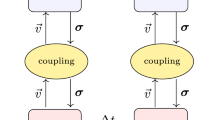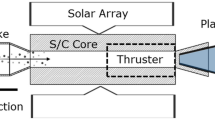Abstract
It is common for an aircraft to encounter icing weather conditions, which would be dangerous to the flight. Thus, there is a need to study the detail of icing effect and the process of ice accretion on the aircraft. In this paper, considering three different icing models according to weather conditions, i.e., sharp-angled ice, blunt-nosed ice and double horn ice, the Reynoldsaveraged N-S equations and the S-A turbulence model are used to analyze the flow field for an iced wing/body configuration with a multi-block strategy and structured grid technique. The numerical result is compared with the experimental data. A flow solver is developed based on the Euler equations to investigate the ice accretion process. The droplets are tracked by using the Lagrangian method. In addition, a revised Messinger model is proposed to simulate the ice accretion. This numerical simulation is conducted for the ice accretion on an M6 wing and a wing/body/tail configuration. The presented results preliminarily show that the numerical methods are feasible and effective.
Similar content being viewed by others
References
Montreuil E, Chazottes A, Guffondi D. Enhancement of prediction capability in icing accretion and related performance penalties. AIAA paper 2009-3969, 2009
Reehorst A, Chung J, Potapczuk M, et al. Study of icing effects on performance and controllability of an accident aircraft. AIAA paper 1999-0374, 1999
Potapczuk M G. A review of NASA Lewis’ development plans for computational simulation of aircraft icing. AIAA paper 1999-0243, 1999
Harold E A, Mark G P, David W S. Modern airfoil ice accretions. AIAA paper 1997-0174, 1997
Frank T L, Abdollah K. Effects of ice accretions on aircraft aerodynamics. Prog Aerosp Sci, 2001, 37: 669–767
Ruff G A, Berkowitz B M, User’s manual for the NASA Lewis ice accretion prediction code (LEWICE). NASA CR-185129, 1990
Beaugendre H, Morency F, Habashi W G. ICE3D FENSAP-ICE’s 3D in-flight ice accretion module. AIAA paper 2002-7134, 2002
Hedde T, Guffond D. ONERA three-dimensional icing model. AIAA J, 1995, 33: 1038–1045
Bragg M B, Broeren A P, Blumenthal L A. Iced-airfoil aerodynamics. Prog Aerosp Sci, 2005, 41: 323–362
Yang K, Xu S J. Wing tip vortex structure behind an airfoil with flaps at the tip. Sci China-Phys Mech Astron, 2011, 54: 743–747
Xu G L, Xiao Z X, Fu S. Analysis of the secondary instability of the incompressible flows over a swept wing. Sci China-Phys Mech Astron, 2011, 54: 724–736
Xu G L, Xiao Z X, Fu S. Secondary instability control of compressible flow by suction for a swept wing. Sci China-Phys Mech Astron, 2011, 54: 2040–2052
Ji S Y. Probability analysis of contact forces in quasi-solid-liquid phase transition of granular shear flow. Sci China-Phys Mech Astron, 2013, 56: 395–403
Bidwell C, Papadakis M. Collection efficiency and ice accretion characteristics of two full scale and one 1/4 scale business jet horizontal tails. NASA TM-213653, 2005
Jung S K, Shin S M, Myong R S, et al. Ice accretion effect on the aerodynamic characteristics of KC-100 aircraft. AIAA paper 2010-1237, 2010
Cao Y H, Zhong G, Ma C. Numerical simulation of ice accretion prediction on multiple element airfoil. Sci China Tech Sci, 2011, 54: 2296–2304
Kong W, Liu H. An ice accretion model for aircraft icing based on supercooled icing: theory and application. AIAA paper 2012-1205, 2012
Sang W, Li F, Shi Y. Icing effect study for wing/body and high-lift wing configurations. AIAA paper 2007-1007, 2007
Li J, Li F, E Q. Numerical simulation of transonic flow over wing-mounted twin-engine transport aircraft. J Aircraft, 2000, 37: 469–478
Chen S Y, Chen Y C, Xia Z H, et al. Constrained large-eddy simulation and detached eddy simulation of flow past a commercial aircraft at 14 degrees angle of attack. Sci China-Phys Mech Astron, 2013, 56: 270–276
Jameson A. Numerical solutions of Euler equations by finite volume methods with Runge-Kutta time stepping schemes. AIAA paper 1981-1259, 1981
Spalart P R, Allmaras S R. A one-equation turbulence model for aerodynamic flows. AIAA paper 1992-0439, 1992
Daniel da S M, Luis G T, Rodrigo H D, et al. Quasi-3D multi-step ice accretion simulation. AIAA paper 2012-0313, 2012
Gao Y Y, He F, Shen M Y. Aerodynamic airfoil design using the Euler equations based on the dynamic evolution method and the control theory. Sci China-Phys Mech Astron, 2011, 54: 697–702
Gaitonde A L. A dual-time method for the solution of the unsteady Euler equations. Aeronaut J, 1994, 98: 283–291
Sang W, Li F. An unstructured/structured multi-layer hybrid grid method and its application. Int J Numer Meth Fl, 2007, 53: 1107–1125
Zhou Z. Numerical simulation of aircraft icing and complex flow fields based on N-S equations (in Chinese). Dissertation of Doctoral Degree. Xi’an: Northwestern Polytechnical University, 2011
Mingione G, Brandi V, Esposito B. Ice accretion prediction on multi-element airfoils. AIAA paper 1997-0177, 1997
Zhou Z, Li F, Li G, et al. Icing numerical simulation for single and multi-element airfoils. AIAA paper 2010-4232, 2010
AL-Khalil K M, Keith T G, Witt K J. Development of an improved model for runback water on aircraft surfaces. J Aircraft, 1994, 31: 271–278
Myers T G. An extension to the Messinger model for aircraft icing. AIAA J, 2001, 39: 211–218
Author information
Authors and Affiliations
Corresponding author
Rights and permissions
About this article
Cite this article
Sang, W., Shi, Y. & Xi, C. Numerical simulation of icing effect and ice accretion on three-dimensional configurations. Sci. China Technol. Sci. 56, 2278–2288 (2013). https://doi.org/10.1007/s11431-013-5277-3
Received:
Accepted:
Published:
Issue Date:
DOI: https://doi.org/10.1007/s11431-013-5277-3




